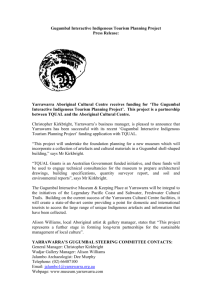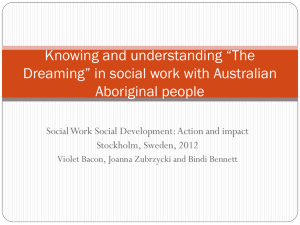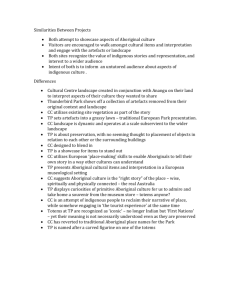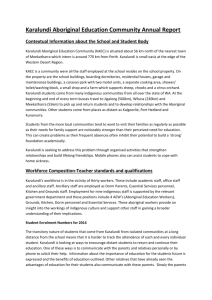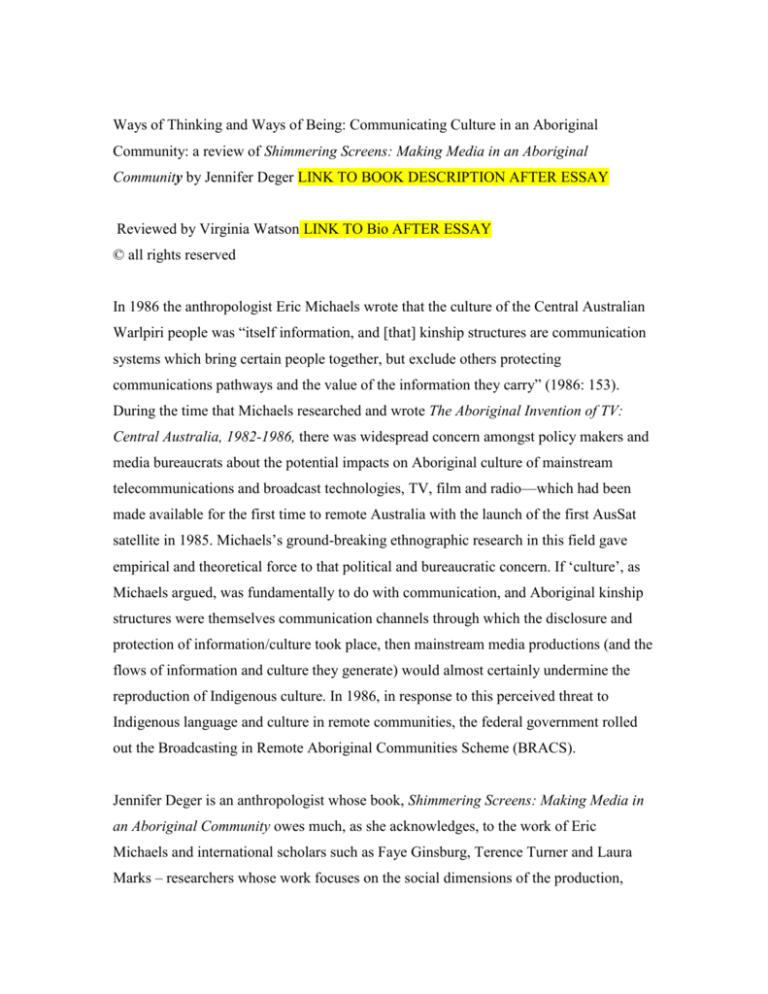
Ways of Thinking and Ways of Being: Communicating Culture in an Aboriginal
Community: a review of Shimmering Screens: Making Media in an Aboriginal
Community by Jennifer Deger LINK TO BOOK DESCRIPTION AFTER ESSAY
Reviewed by Virginia Watson LINK TO Bio AFTER ESSAY
© all rights reserved
In 1986 the anthropologist Eric Michaels wrote that the culture of the Central Australian
Warlpiri people was “itself information, and [that] kinship structures are communication
systems which bring certain people together, but exclude others protecting
communications pathways and the value of the information they carry” (1986: 153).
During the time that Michaels researched and wrote The Aboriginal Invention of TV:
Central Australia, 1982-1986, there was widespread concern amongst policy makers and
media bureaucrats about the potential impacts on Aboriginal culture of mainstream
telecommunications and broadcast technologies, TV, film and radio—which had been
made available for the first time to remote Australia with the launch of the first AusSat
satellite in 1985. Michaels’s ground-breaking ethnographic research in this field gave
empirical and theoretical force to that political and bureaucratic concern. If ‘culture’, as
Michaels argued, was fundamentally to do with communication, and Aboriginal kinship
structures were themselves communication channels through which the disclosure and
protection of information/culture took place, then mainstream media productions (and the
flows of information and culture they generate) would almost certainly undermine the
reproduction of Indigenous culture. In 1986, in response to this perceived threat to
Indigenous language and culture in remote communities, the federal government rolled
out the Broadcasting in Remote Aboriginal Communities Scheme (BRACS).
Jennifer Deger is an anthropologist whose book, Shimmering Screens: Making Media in
an Aboriginal Community owes much, as she acknowledges, to the work of Eric
Michaels and international scholars such as Faye Ginsburg, Terence Turner and Laura
Marks – researchers whose work focuses on the social dimensions of the production,
circulation and reception of media in Indigenous communities. Two decades after
Michaels completed the The Aboriginal Invention of Television, however, Deger’s work
challenges us to rethink his legacy and, in particular, the political and bureaucratic
anxieties that resulted in the development of BRACS. She develops a subtle and original
analysis of the ways in which culture is negotiated through media technologies that at the
same time, as a result, productively enriches international scholarship in Indigenous
media, anthropology and visual culture.
When Deger began her research in 1993, she imagined that she would be investigating
“the discourses, policies and practices that shaped the possibilities of BRACS and other
media projects of representation, resistance, and cultural revival” (2006: 3). This never
happened. She spent a year travelling across northern Australia looking at the work of
Indigenous media associations trying to identify communities where BRACS was being
used to produce local media content. With one notable exception, in South Australia, she
could find no example of a community in which there was any sustained local media
production. She began to worry about the continuing enthusiasm for BRACS amongst
Indigenous media advocates when there was apparently almost no Indigenous broadcast
production taking place. Was this just a question of a lack of resources and appropriate
media training? When she managed to convince the local council in the small Aboriginal
settlement of Gapuwiyak in northeast Arnhem Land to take her on as a volunteer BRACS
trainer/administrator, she knew she had found her field site to investigate these questions
but, as she remarks, she was “to begin research on something that did not yet exist”
(2006: 9).
Deger set about her volunteer work at Gapuwiyak and trained two local Yolngu people as
BRACS operators. Working with them over the following months, it became clear to her
that even with the training and resources to develop and produce local, cultural content,
the Yolngu staff only appeared to be interested in using BRACS to broadcast content
produced by mainstream providers. It was at this point, as she narrates it, that it became
clear to her that Michaels’s model of a proactive, interventional research strategy no
longer made sense. Rather than using BRACS to produce local cultural content (and in
Michaels’s terms strengthen the possibilities for cultural survival) Yolngu actually
seemed to see themselves as “actively protecting culture by not recording and not
broadcasting their songs and stories” (2006: 18). It looked as though her research was
going to result in a critique of the disjunctions between policy discourses and Aboriginal
cultural practice. And then she met Bangana Wunungmurra.
Bangana, as Deger so engagingly describes him, was a Yolngu man distinguished by the
ease with which he understood both the balanda (whitefella) administrative apparatus
and his knowledge of Yolngu rom (Law). As Deger described the work she was doing
with BRACS to him, he quickly appraised its potential and utterly surprised Deger,
saying: “Yapa [sister]. We can use this media to strengthen Yolngu culture” (2006: 19).
And so began a collaboration between Deger and Bangana to produce a video project.
The video, Gularri: That Brings Unity tells the story of the sacred fresh waters that flow
through the waterholes, rivers and seas of the Yirritja clan countries across northeast
Arnhem Land in the Northern Territory. As Deger describes this:
Infused with Ancestral potency, replete with layers of story and significances,
Gularri, and the sacred sites associated with it, is an important source of Yolngu
identity. For Yolngu of the Yirritja moiety, these waters are a foundational source:
not only do they and the rangga [sacra] come from Gularri: they are Gularri.
Gularri does not simply represent them, it is them” (2006: 138).
It is this deeply ontological conception of Gularri, and of the nature of cultural
production and ritual practice, that Deger sets out in Shimmering Screens that is so
startling and original.
Drawing on Walter Benjamin and Michael Taussig on mimesis, and Martin Heidegger on
technology, Deger develops an analysis of the way in which media technologies,
particularly film, produces a constitutive relationship between objects, people and places
which extends far beyond the transmission of signs, the representation of images and the
conveying of information. Departing from earlier conceptions of culture as information,
and film, video and broadcasting as texts or circuits of information flow (the ‘semiotic’
analyses found, for example, in the work of Eric Michaels), Deger shows how the
mimetic quality and uses of media in Yolngu media ‘presence’ objects, places and
people. The central place of mimesis in the Yolngu imagination, Deger argues, therefore
takes film and video “beyond the production of likeness to something more akin to an
ontological sameness” (2006: 100). In this way, the mimetic power of ‘presencing’ the
sacra and Ancestral in Gularri is understood as the very act of making Yolngu culture
and its ontological world – the Yolngu way of being-in-the world. For Bangana, making
culture then is about showing the sacra and the Ancestral in ways that protect culture
from the un-initiated viewer, but which also educate balanda and yet to be initiated
younger Yolngu. As Deger tells us:
Yolngu are offering up ancestrally charged images in the understanding that an
exposure to Ancestral presence, in combination with constitutive acts of showing,
presencing, giving, receiving, and seeing produces a relationship (2006: 113).
Bangana Wunungmurra died suddenly in 2002 at the age of thirty-seven. Shimmering
Screens is a direct and emotionally honest tribute to the man who made this book
possible in the first place, as well as his surviving family who encouraged publication.
Few ethnographers are ever so explicit and comprehensive in recognizing their debt to
their informants. Hopefully, Jennifer Deger will continue to work with the people of
Gapuwiyak notwithstanding Wunungmurra’s death. We need more of this kind of
complex and challenging analysis of Aboriginal being-culture.
At a time when the average life expectancy for Indigenous men is nineteen years less
than their non-Indigenous counterparts, when Australian army personnel and federal
police have been dispatched to communities throughout the Northern Territory such as
Gapuwiyak to restore law and order, and protect the safety of women and children in
particular, I wonder, however, whether Deger might not also find a way to join up her
ontologically informed analysis of culture with her earlier concerns with the disjunctions
and misunderstandings of policy and administration in Indigenous Affairs and the
cultural practices of its subjects.
Shimmering Screens: Making Media in an Aboriginal Community by Jennifer Deger was
published by University of Minnesota Press, Minneapolis, in 2006.
Virginia Watson lectures in Social Inquiry in the Faculty of Humanities and Social
Sciences at UTS. She has published on policy and administration in Indigenous Affairs
and is currently working on a research project with the Consumer
Telecommunications Network which examines the uses of ICTs in remote
Indigenous communities.
Work Cited
Michaels, Eric. (1986) The Aboriginal Invention of Television: Central Australia 19821986, Canberra: Australian Institute of Aboriginal Studies.
In Australian Humanities Review, see also:
the Indigenous Issues archive
▪


